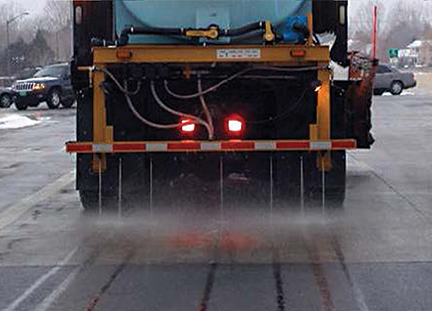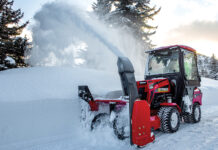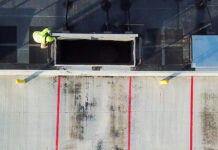When it comes to anti-icing and/or deicing the first question you should ask is: what is the service goal of the property? You will also need to take into consideration the impact on vegetation of the products used on the property. Your answer will determine your plan of attack, but the best programs will always use a combination of liquids and dry when it comes to managing a property.
Anti-icing
Let’s take a look at the difference between anti-icing and deicing. Anti-icing involves applying material prior to a storm, while deicing means applying material after the snow or ice is on the ground. Why anti-ice? Anti-icing buys precious time. You can spray down all your properties prior to the storm—and then have more time to effectively clear off snow once it starts to fall. The spray product on the surface will prevent the snow and or ice from bonding to the surface. Then, when you go in with clearing equipment, you get to a bare surface much easier. (It’s like putting Pam on a frying pan to help keep your food from sticking.) A common fallacy about anti-icing practices is that they will cause a lot of melting, but this isn’t true. Anti-icing practices are simply a tool to help you remove snow and ice from the road or parking lot surface faster and easier.
Liquids are the best anti-icing method because they stay on the surface. Dry material can bounce and scatter, possibly disappearing by the time the storm arrives. A critical component of anti-icing practices is determining how far in advance of the storm the product can effectively be applied. Not all anti-
icing products act the same. Some products can be applied a few days prior to a storm—they effectively “dry” on the road surface and will still be intact when it the storm arrives. Other liquids, however, will not “dry” to the surface. These types of products are more effective, last longer, and work at lower temperatures, but need to be put down closer to the storm.
Deicing
If you have the capability to anti-ice, you obviously have the capability to deice with liquids as well. This is where the products you use and the level of service to be maintained on the property come into play. Understand that the products you choose will determine effectiveness. Products vary in effective temperature range from 15˚F down to -10˚F. Keep in mind that “effective” temperatures for deicing products are actually the surface temperature, not the air temperature. If you work in a region with constant cold temperatures during the winter, you may want to consider a higher value material like a magnesium or calcium chloride that can handle all temperature ranges.
When deicing with liquids, the material is still applied after the storm has started, but at a higher application rate than when you anti-ice. Generally, you will find you apply about twice as much product for deicing versus anti-
icing with liquids. More product is used for deicing because it has to penetrate through the snow and ice to get to the surface—which will again allow you to remove the snow or ice off the property faster. However, the product used will determine your application rate, so it’s important to consult with your supplier. While you will get melting when deicing, keep in mind that as the product penetrates the snow and ice, it is diluting the deicer. Higher value materials will not dilute as quickly, therefore less will be required.
When applying liquids, be sure to use a pencil spray. This is important not so much for ant-icing, but for the deicing. A pencil spray allows the product to drill down though the snow and ice without dilution. With a fan spray, the product will melt on top and never reach the road surface. This will cost you time and money since the liquid will not be as effective as intended.

Dry Material
Using liquids for anti-icing and deicing can be a great tool to help you with time management when handling a predicted storm. And liquids can also save you money if used properly. However, a dry deicer should always be on hand as well, since there are few storms where liquids will get you through an entire event. Depending on snow amount, temperatures, and duration, there are some outstanding dry products available that not only melt snow, but will also work as an abrasive to help prevent slip and falls.
There are all types of dry materials available—from higher priced value-added materials to lower priced commodity materials. The effective temperature range for dry materials can range from 15˚F to -25˚F. Some dry products work at lower temperatures and are less corrosive. Others are available that will meet any required Green or environmental impact standards. Corrosive properties of the products used are also an important consideration when it comes to the life cycle of your equipment.
You can always use liquids in combination with your dry material as pre-wet. All dry material has to turn into a brine before it can start the melting process. So if you spray down the dry product with liquid, you can create an application that will work at lower temperatures and turn into a brine faster with less material. Depending on the type of liquid and dry material used, you can also produce a less corrosive application.
Cost Effectiveness
A major consideration when evaluating any snow management program is cost versus price. You may think using less expensive products for your program is best, but in the end, it could actually be costing you more money. Higher value products will be faster, stronger, and more effective. They allow you to use less product, save more time, and protect your equipment better—all of which impacts the bottom line. Using higher value products also helps a property get to “bare” (and safety) faster, allowing for a high level of customer service. Since products also have different impacts on vegetation and grasses, talk to your ice melt supplier to determine what will be best for your properties.
In my almost 30 years of experience, no one product will effectively get you through the entire winter. Both liquids and dries, when used properly, can save time and money. Sit down with your product supplier and discuss the advantages and disadvantages of both liquids and dries so you find the right combination for your area and needs to maximize success.
Duran spent the majority of his career as VP of Sales for EnviroTech Services Inc., based in Greeley, CO. He currently works as a consultant, primarily focusing on sales, sales management, and strategic planning. He continues to work with companies in the winter maintenance business.
Do you have a comment? Share your thoughts in the Comments section below, or send an e-mail to the Editor at acosgrove@groupc.com.











![[VIDEO] Dickies®: Discover Workwear That’s Anything But Uniform](https://turfmagazine.com/wp-content/uploads/2023/06/1647663814-4b1a2a7742790a9b1e97a3b963477850192e1d6a9dfba9b07214a77bae25d6e3-d-218x150.jpg)






























![[VIDEO] Dickies®: Discover Workwear That’s Anything But Uniform](https://turfmagazine.com/wp-content/uploads/2023/06/1647663814-4b1a2a7742790a9b1e97a3b963477850192e1d6a9dfba9b07214a77bae25d6e3-d-324x160.jpg)